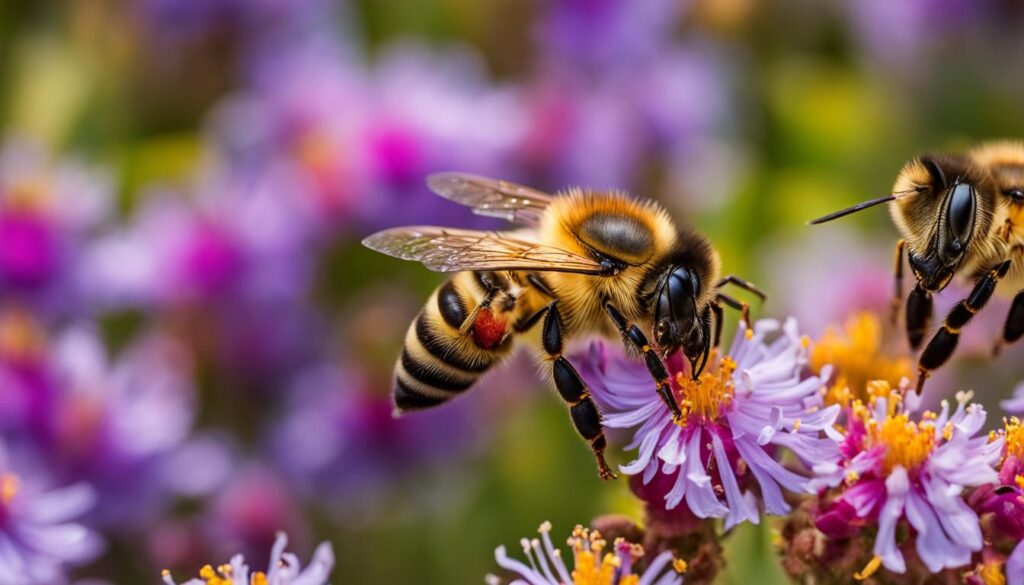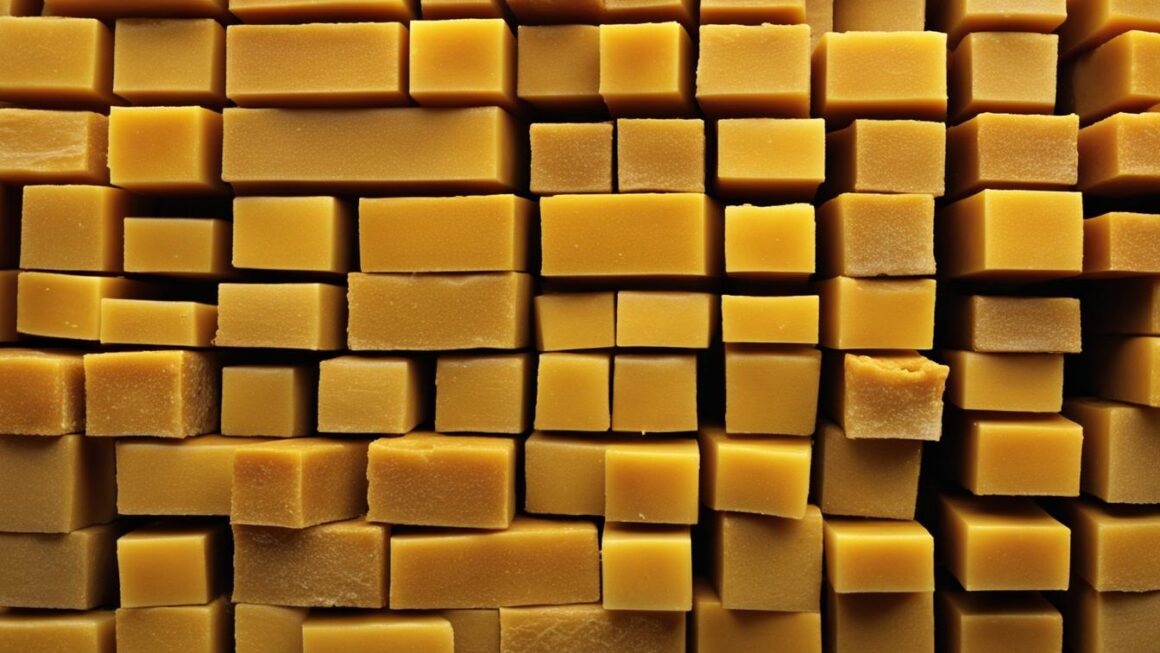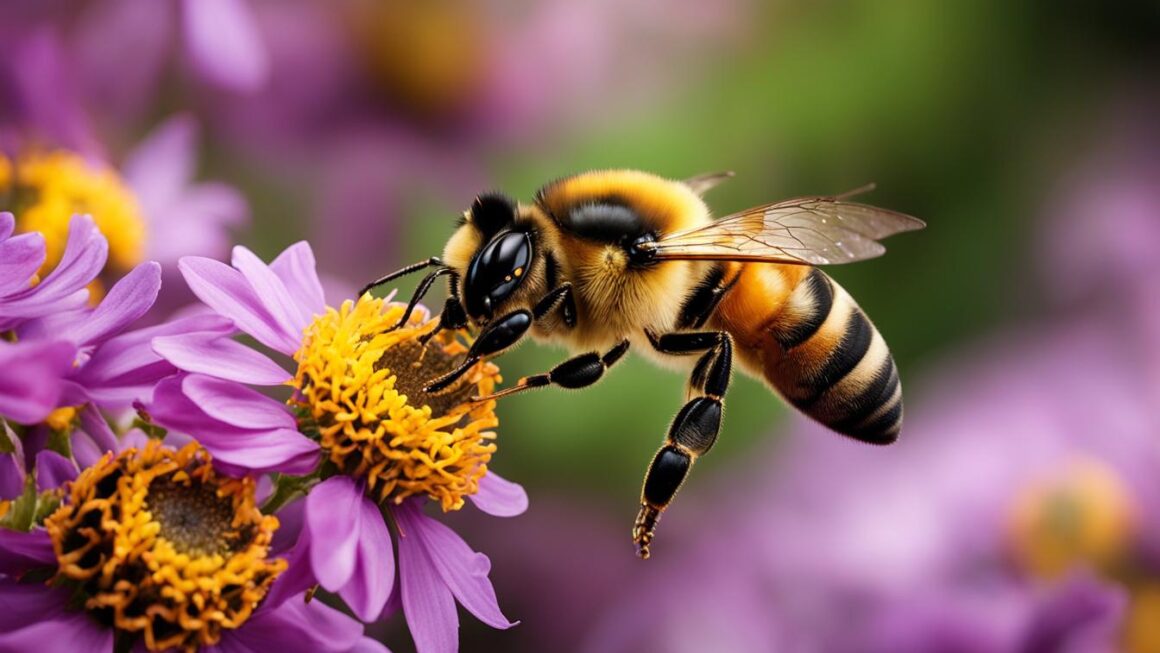Bee pollen is a nutritional powerhouse packed with essential nutrients. It is collected by bees during the process of foraging for nectar and pollen from flowers. During this process, bees mix the collected pollen with nectar and bee saliva, forming small pellets that are then stored in the hive. Bee pollen contains a wide range of vitamins, minerals, proteins, and antioxidants, making it a valuable food source for both bees and humans.
Key Takeaways:
- Bee pollen is collected by bees during the foraging process.
- Bees mix the collected pollen with nectar and bee saliva.
- Bee pollen is stored in the hive for future use.
- Bee pollen is rich in essential nutrients, including vitamins, minerals, proteins, and antioxidants.
- Bee pollen is beneficial for both bees and humans.
The Role of Bee Pollen in Pollination
Bees play a crucial role in the pollination process, and bee pollen is a key component in facilitating this important ecological function. When bees collect pollen from flowers, it adheres to their bodies due to the sticky nature of the pollen grains. As bees visit other flowers, some of the pollen is transferred from one flower to another, resulting in pollination. This transfer of pollen is essential for the fertilization of plants and the production of fruits and seeds.
Without the help of bees and the distribution of bee pollen, many plant species would struggle to reproduce effectively. Insect pollination, particularly by bees, is responsible for a significant portion of the world’s food production. It is estimated that nearly 80% of flowering plants depend on animals, including bees, for pollination. This mutualistic relationship between bees and plants contributes to the diversity and sustainability of plant species, enabling the continuation of ecosystems and the preservation of natural habitats.
What makes bee pollen particularly effective in aiding pollination is its ability to easily adhere to the bodies of bees. The shape, texture, and size of bee pollen grains, along with the adhesive properties of the pollen, allow for efficient transfer from flower to flower. This ensures a higher likelihood of successful pollination and the subsequent development of fruits and seeds.
The Role of Bee Pollen in Pollination
| Benefits of Bee Pollen in Pollination | Importance |
|---|---|
| Facilitates effective pollination | Ensures fertilization of plants |
| Contributes to the production of fruits and seeds | Supports plant reproduction |
| Enhances plant diversity and sustainability | Aids in the continuation of ecosystems |
The role of bee pollen in pollination cannot be overstated. It is a vital link in the intricate web of nature, ensuring the successful reproduction and proliferation of plant species. Without bees and the valuable assistance they provide in the pollination process, the world as we know it would be a very different place, with reduced biodiversity and significant impacts on food production.
The Journey of a Bee Collecting Pollen
Honeybees are skilled foragers, embarking on a remarkable journey to collect pollen. This behavior is essential for their survival and plays a vital role in pollination. Let’s explore the fascinating journey of a bee collecting pollen, from leaving the hive to filling their pollen baskets.
Foraging and Navigation
When it’s time to collect pollen, worker bees leave the hive in search of flowers. These remarkable insects rely on their keen sense of smell and vision to locate suitable blooms. They navigate through their surroundings, skillfully avoiding obstacles and recognizing familiar landmarks. By foraging within a radius of three miles from the hive, honeybees gather nectar and pollen from a variety of flowering plants.
Collecting Pollen
Once a honeybee finds a flower, it begins the process of collecting pollen. The bee inserts its proboscis into the flower to gather nectar, while simultaneously using its hairy legs to scrape pollen from the anthers. The pollen sticks to the bee’s body due to its static charge and the sticky nature of the pollen grains. As the bee moves from flower to flower, some of the collected pollen brushes against the receptive stigma, facilitating pollination.
The Pollen Baskets and Returning to the Hive
The collected pollen is transferred to specialized structures on the hind legs of the honeybee called pollen baskets or corbiculae. These baskets are concave areas surrounded by hairs that hold the pollen firmly in place. As the bee continues to visit more flowers, it fills its pollen baskets with additional pollen until they are fully loaded. When the bee returns to the hive, it unloads the collected pollen to be stored and used as a valuable food source for the colony.
The journey of a bee collecting pollen showcases their incredible intelligence and vital role in the life cycle of plants. Through their foraging and pollination activities, bees contribute to the pollination of countless plant species, ensuring the production of fruits, seeds, and a diverse ecosystem.
The Nutritional Value of Bee Pollen
Bee pollen is often referred to as nature’s superfood due to its impressive nutritional profile. It is rich in vitamins, minerals, proteins, and antioxidants, making it a valuable addition to a healthy diet.
When it comes to vitamins and minerals, bee pollen is packed with nutrients. It contains nearly all B vitamins, including a high amount of folate (vitamin B-9), which is essential for overall health and development. It also provides a wide range of amino acids, including all 21 essential amino acids, making it a complete protein source.
Bee pollen is also a powerhouse of antioxidants. It contains a variety of beneficial compounds, such as flavonoids and carotenoids, which help protect the body against oxidative stress. These antioxidants play a vital role in promoting overall health and well-being.
The Nutritional Profile of Bee Pollen
| Nutrient | Amount per 100g |
|---|---|
| Protein | 20g |
| Carbohydrates | 50g |
| Fat | 5g |
| Vitamin B-9 (Folate) | 400mcg |
| Essential Amino Acids | All 21 |
| Flavonoids | 100mg |
| Carotenoids | 50mg |
“Bee pollen is a nutritional powerhouse, packed with vitamins, minerals, proteins, and antioxidants. Its impressive profile makes it a valuable addition to a healthy diet.”
Incorporating bee pollen into your routine can provide a wide range of health benefits. Its nutrient content supports overall well-being and can boost the immune system. Additionally, the antioxidants in bee pollen have anti-inflammatory effects, promoting skin health and soothing the digestive system.
However, it is important to note that individual results may vary, and it is always recommended to consult a healthcare professional before making any significant dietary changes, especially if you have allergies or sensitivities.

The Benefits of Bee Pollen for Health and Wellness
| Benefits of Bee Pollen | Description |
|---|---|
| Immune Support | Bee pollen can help boost the immune system, offering support for overall health and well-being. |
| Energy Boost | Consuming bee pollen may increase energy levels and reduce fatigue, providing a natural energy boost. |
| Skin Health | The antioxidants in bee pollen can have anti-inflammatory effects, promoting skin health and a youthful appearance. |
| Healthy Digestion | Bee pollen’s anti-inflammatory properties may help soothe the digestive system, promoting healthy digestion. |
Bee Pollen as a Natural Superfood
Bee pollen is often hailed as a natural superfood due to its exceptional nutritional content. It is a powerhouse of essential nutrients, including vitamins, minerals, proteins, and antioxidants. Bee pollen contains a wide range of beneficial compounds that contribute to its superfood status, such as powerful antioxidants like flavonoids and carotenoids. These antioxidants help protect the body against the damaging effects of free radicals, promoting overall health and well-being.
The nutritional profile of bee pollen makes it a nutritional gem. It is packed with vitamins such as vitamin A, vitamin C, and the entire spectrum of B vitamins. It also provides essential minerals like calcium, magnesium, and zinc. Additionally, bee pollen is a rich source of complete proteins, containing all 21 essential amino acids that the body needs for optimal functioning.
“Bee pollen is a true powerhouse of nutrition, offering a wide range of health benefits. Its antioxidant properties help fight inflammation and protect against oxidative stress, while its nutrient-rich composition supports overall vitality and well-being.”
The Antioxidant Power of Bee Pollen
One of the key reasons why bee pollen is considered a superfood is its powerful antioxidant content. Antioxidants play a crucial role in neutralizing harmful free radicals in the body, which can otherwise lead to cellular damage and chronic diseases. Bee pollen’s antioxidant compounds, such as flavonoids and carotenoids, provide protection against oxidative stress and help maintain a healthy immune system.
Table:
| Antioxidant | Concentration in Bee Pollen |
|---|---|
| Quercetin | High |
| Rutin | High |
| Lutein | Moderate |
| Zeaxanthin | Moderate |
| Beta-carotene | Moderate |
The presence of these powerful antioxidants in bee pollen makes it a valuable addition to a well-balanced diet. These compounds have been linked to numerous health benefits, including reduced inflammation, enhanced immune function, and improved cardiovascular health.
Bee pollen is a nutritional gem packed with powerful antioxidants that can support overall health and well-being. Its nutrient-rich composition makes it a true superfood, providing essential vitamins, minerals, proteins, and antioxidants. Consider incorporating bee pollen into your diet to reap the numerous health benefits it offers.
The Collection and Storage of Bee Pollen
When it comes to the collection and storage of bee pollen, beekeepers play a crucial role in ensuring the quality and integrity of this valuable substance. Specialized pollen traps are strategically placed at the entrance of the beehive, allowing bees to enter while removing loose pollen from their bodies. This collection process is carefully managed to minimize disruption to the bees and prevent any harm to their delicate bodies. The collected pollen is then stored in containers or undergoes freeze-drying to preserve its nutritional value and prevent spoilage.
Beekeepers understand the importance of proper collection and storage techniques to maintain the freshness and quality of bee pollen. The pollen is handled with care to prevent contamination and oxidation, which could lead to a decrease in its nutritional value. By following established standards and protocols, beekeepers ensure that the bee pollen remains pure and free from any harmful substances or impurities.
Proper storage is essential to prevent degradation of the bee pollen’s nutritional properties. The containers used for storage are airtight, protecting the pollen from exposure to light, moisture, and oxygen. This helps to maintain the potency of the bee pollen, ensuring that it retains its valuable nutrients and health benefits for an extended period.
Table: Overview of Bee Pollen Collection and Storage
| Step | Description |
|---|---|
| Placement of pollen traps | Specialized traps are placed at beehive entrances to collect loose pollen from bees’ bodies. |
| Collection process | Pollen is carefully removed from the traps, ensuring minimal disruption to the bees. |
| Storage method | Pollen is stored in airtight containers or undergoes freeze-drying to preserve its nutritional value. |
| Purity and quality control | Beekeepers adhere to established standards to maintain the freshness and purity of bee pollen. |
| Proper storage conditions | Pollen is stored in a cool, dark, and dry environment to prevent degradation. |
Bee Pollen Varieties and Quality
Bee pollen can vary in composition depending on the plants from which it is collected. Different plant species produce pollen with unique nutritional profiles and flavors, resulting in a diverse range of bee pollen varieties. Some common bee pollen varieties include:
- Wildflower bee pollen
- Citrus bee pollen
- Forest bee pollen
- Herbal bee pollen
The composition of bee pollen is influenced by various factors, including geographical location, climate, and beekeeping practices. For example, bee pollen collected from different regions may contain varying levels of specific vitamins, minerals, and antioxidants. Climate conditions, such as the presence of certain plant species or exposure to pesticides, can also impact the composition of bee pollen.
To ensure the quality and integrity of bee pollen, established standards have been put in place. These quality standards regulate factors such as moisture content, microbiological contamination, and pesticide residues. Beekeepers follow these standards to maintain the purity and safety of bee pollen, ensuring that it meets the highest quality requirements.
Pollen Composition Comparison
| Bee Pollen Varieties | Nutritional Composition | Flavor Profile |
|---|---|---|
| Wildflower bee pollen | High in a wide range of vitamins, minerals, and antioxidants | Sweet and floral |
| Citrus bee pollen | Rich in vitamin C and flavonoids | Tangy and citrusy |
| Forest bee pollen | Abundant in antioxidants and minerals like zinc | Earthy and slightly woody |
| Herbal bee pollen | Contains a variety of beneficial plant compounds | Herbaceous and aromatic |
Each bee pollen variety offers its own unique set of nutritional benefits and flavor characteristics. It’s important to choose a bee pollen variety that aligns with your dietary preferences and health goals. Whether you prefer the sweetness of wildflower bee pollen or the tang of citrus bee pollen, incorporating bee pollen into your routine can provide you with a natural and nutrient-rich boost.
Conclusion
Bee pollen is a fascinating substance with remarkable nutritional benefits and an essential role in pollination. Its collection and storage by bees contribute to the sustainability and diversity of plant species. Bee pollen offers a wide range of vitamins, minerals, proteins, and antioxidants, making it a valuable addition to a healthy diet.
However, it is important to consult a healthcare professional before incorporating bee pollen into your routine, especially if you have any allergies or sensitivities. Beekeepers play a crucial role in ensuring the quality and integrity of bee pollen, following established standards to maintain its purity and safety.
Consider exploring the wonders of bee pollen and its potential to enhance your well-being and vitality.
FAQ
What is bee pollen?
Bee pollen is a nutrient-rich substance collected by bees during the process of foraging for nectar and pollen from flowers. It is a combination of pollen grains, nectar, and bee saliva.
How is bee pollen collected?
Bees collect pollen by rubbing their hairy legs against the anthers of flowers, causing the pollen grains to stick. They then transfer the collected pollen to specialized structures on their hind legs called pollen baskets.
What nutrients are found in bee pollen?
Bee pollen is packed with vitamins, minerals, proteins, and antioxidants. It contains a wide range of B vitamins, essential amino acids, and various antioxidants like flavonoids and carotenoids.
What are the health benefits of consuming bee pollen?
Bee pollen can support overall well-being, boost the immune system, increase energy levels, reduce fatigue, promote skin health, and provide anti-inflammatory effects. However, it’s important to consult a healthcare professional before making dietary changes.
How is bee pollen collected and stored?
Beekeepers use specialized pollen traps to collect loose pollen from bees. The collected pollen is then stored in containers or freeze-dried to preserve its nutritional value.
Does the composition of bee pollen vary?
Yes, the composition of bee pollen can vary depending on the plants from which it is collected, geographical location, climate, and beekeeping practices.
Are there quality standards for bee pollen?
Yes, quality standards have been established to ensure the purity and safety of bee pollen. These standards regulate factors such as moisture content, microbiological contamination, and pesticide residues.




